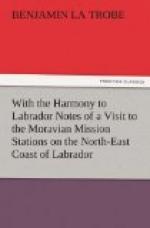Thursday, September 6th.—We have had a rough night. This morning we are off Hebron, but twenty-five miles out to sea. We have just passed “the Watchman,” an island which serves as a waymark for the entrance to that station. I asked the mate, who once spent a winter there, whether the missionaries or the Eskimoes could see us from the heights near it. He replied that there was no doubt of it, but that he had looked out in this direction from those hills, where no drop of water was visible, nothing but an illimitable plain of ice stretching far beyond where we are now sailing.
Sunday, 9th.—Safe at Ramah, thank God, and not out in the fog, which now envelopes sea and land. The last two days have been a trial of patience. We have seen the entrance to this Nullatatok Bay all the time, and longed to reach the desired haven, yet have not been able, owing to calms and contrary currents. This Labrador coast becomes ever bolder and grander as one sails northward. Here the snowy mountains are quite Alpine in appearance. This morning the thick mist hides all but the base of these magnificent hills, but the enormous rocky masses, rising so quickly from the water’s edge into the heights veiled from us, give some idea of their grandeur. Our captain is, indeed, well acquainted with their aspect or he would not have ventured to enter this bay under such circumstances.
“RAMARSUK” (NEAT LITTLE RAMAH).
[Illustration]
Missionaries all over the world are perhaps too fond of multiplying Scripture names of their stations. In our own fields we have already three Bethanys and three Bethesdas. We should have had three Ramahs too, had not the natives of Australia themselves greatly improved the appellation of theirs by adding to it a syllable meaning “home” or mother’s place. It seemed so homelike to the Christian Aborigines, who moved thither from Ebenezer, the older station, that they at once called it Ramahyuck (Ramah, our home). Perhaps as the Ramah on the Moskito Coast is also known as Ramah Key, the northern station in Labrador, founded in 1871 to mark the cenutry of that mission, should abide plain, simple “Ramah,” otherwise the above combination would, I understand, have suited the genius of the language, and its significance. “Neat little Ramah” certainly expresses the character of the lonely missionary settlement.
The village, if one may dignify this small group of human dwellings by that name, stands on a little plain evidently won by degrees from the sea for the successive beaches can be traced. The mission premises, the old house, the new house, and the church with its little belfry, are one continuous building facing the bay southward, and exactly one hundred feet in length. Behind are the store buildings, and the low turf huts of the natives stretch westward along the strand. They are so like grassy mounds, that from any distance one would ask, “But where do the Eskimoes live?”




